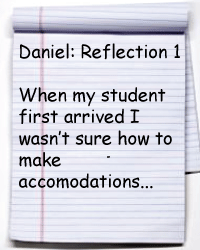Working with ELL/ESL Students
 In today’s classrooms teachers work with a variety of students with a diverse range of backgrounds and therefore a wide variety of learning needs. Statistics show that Canada's foreign-born population is at its highest level in 70 years and Canada’s visible minority population has tripled since 1981 (Coalition for Equal Access to Education). What do these statistics mean for classroom teachers? Given the continuing growth of culturally diverse populations, more school-age children will enter the public school system with unique linguistic and socio-cultural needs. In the case of Daniel we can see that he feels untrained and unsure about how to accommodate for the ELL student in his social studies class. In this section we will look at some strategies for working with ELL students in the mainstream classroom. In today’s classrooms teachers work with a variety of students with a diverse range of backgrounds and therefore a wide variety of learning needs. Statistics show that Canada's foreign-born population is at its highest level in 70 years and Canada’s visible minority population has tripled since 1981 (Coalition for Equal Access to Education). What do these statistics mean for classroom teachers? Given the continuing growth of culturally diverse populations, more school-age children will enter the public school system with unique linguistic and socio-cultural needs. In the case of Daniel we can see that he feels untrained and unsure about how to accommodate for the ELL student in his social studies class. In this section we will look at some strategies for working with ELL students in the mainstream classroom. |
|
Who Are English Language Learners or English as a Second Language Students?
English Language Learners (ELL) or English as a Second Language (ESL) students are students who first learned to speak, read and/or write a language(s) other than English. ESL students may have recently (im)migrated to Canada or may have been born in Canada and live in homes in which the primary language is not English.
It is important as an educator to understand that just because these students are classified as a general group does not mean that each student can be understood in the same way. Each ELL student will be different from the next and require different accommodations and cultural awareness. It is also important to understand that in addition to coming from a different language background, these students often come from a different cultural, social and political background. School and political systems, cultural norms and values about education differ from culture to culture and therefore it is important as a teacher to try to discover these backgrounds as best as possible in order to better understand each learner.
back to top
What types of accommodations should I use for ELL students in my classroom?
Generally speaking, accommodations that are helpful for ELL students are usually helpful for all students. With this in mind it is important to remember that many of the accommodations that can be made for ELL students can be applied when differentiating for student needs on a regular basis. Below are just a few examples of classroom accommodations for ELL students. (Some strategies adapted from http://lewispalmer.org/default.asp)
General Classroom Accommodations
-
Use a variety of instruction and assessment strategies
-
Use cooperative group learning- reciprocal teaching, learning circles
-
Provide a model or demonstrations of required/expected written or oral responses
-
Use visuals during instruction and accompany print material with visuals for clarification and explanation
-
Allow partner work
-
Explicitly instruct different types of learning strategies
-
Follow predictable routines in order to create an environment of security and stability especially for students new to the language and culture
-
Involve students’ culture and family in school events and projects
-
Create a sense of belonging for EVERY student in the class
Specific Accommodations for ELL students
-
Reduce length and allow more time for written assignments
-
Allow students to substitute drawings, pictures, or diagrams, graphs, charts for a written assignment
-
Accept all attempts at speech production without error correction
-
Assign a personal buddy to help the student learn the layout and rules of school and classroom
-
Seat new ELL's toward the middle or front of the class
Visit our ELL/ESL Resources page for links to web sites with more strategies and ideas for working with ELL students.
back to top
What are some instructional strategies I can use with my ELL students?
Similarly to classroom accommodations, instructional strategies that are effective with ELL students are often just as effective for native speakers or similar to those used in the SL/FL classroom. Watch the videos below to learn some specific strategies for working with ELL students or visit our Strategies and Activities page for more ideas.
The Value of Speaking (time 2:29)
|
Vocabulary Strategies (time 2:58)
|
Are there any specific management strategies I should consider for ELL students?
Due to differences in language and culture, some ELL students might be misperceived as being disruptive or non-responsive in regards to managing the classroom. Dr. Robert Kizlik offers some tips that might be considered in regards to management and ELL students in the mainstream classroom.
- ELL students come from a variety of backgrounds, even in the same country (for example schooled, unschooled, Americanized, etc.) This can lead to different expectations or patterns of behavior.
- ELL students are not stupid and they can hear what is being said. They just don't necessarily understand the language or culture yet.
- It is easy to misunderstand body language and certain behaviors (for example, eye contact, spitting, chalk eating, etc.)
- Don't assume they understand something just because it seems simple to you. Simplify it, boil it down.
- Even when they have lost their accent, they often misunderstand common words and phrases.
- Correct repeated patterns or mistakes (not every single mistake) once students are comfortable in the classroom environment.
back to top

Alberta Education Learning & Teaching Resources for English as a Second Language
http://education.alberta.ca/teachers/program/esl/resources.aspx
Many Roots, Many Voices: Supporting English Language Learners in Every Classroom
http://www.edu.gov.on.ca/eng/document/manyroots/
Culture in ESL classrooms
http://www.yourdictionary.com/esl/Culture-in-ESL-Classrooms.html



